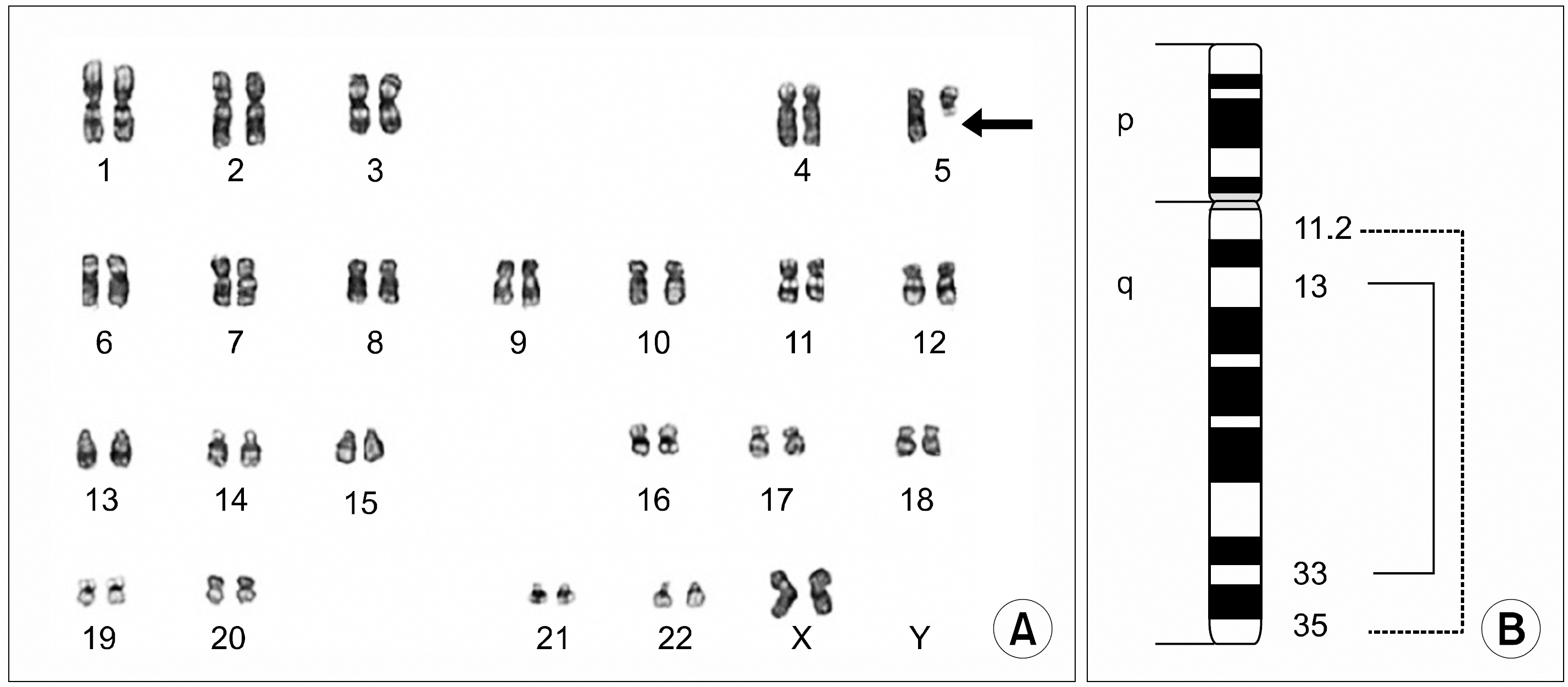Korean J Hematol.
2007 Mar;42(1):43-47. 10.5045/kjh.2007.42.1.43.
A Case of Myelodysplastic Syndrome Associated with an Isolated del(5q) Chromosomal Abnormality Showing Poor Prognosis
- Affiliations
-
- 1Department of Laboratory Medicine, Asan Medical Center, University of Ulsan College of Medicine, Seoul, Korea.
- 2Department of Internal Medicine, Asan Medical Center, University of Ulsan College of Medicine, Seoul, Korea.
- KMID: 2252267
- DOI: http://doi.org/10.5045/kjh.2007.42.1.43
Abstract
- Typical myelodysplastic syndrome (MDS) associated with isolated del(5q) consists of an interstitial deletion of the band between q13 and q33 on chromosome 5. Generally, patients with isolated deletion 5q have better outcomes than those who have the deletion 5q with additional karyotypic abnormalities. Here we report a 47 year-old female with an isolated del(5q) chromosomal abnormality with an atypical breakpoint of 5q11q35 and rapid progression to acute leukemia, which had an exceptionally poor outcome. The peripheral blood revealed pancytopenia and occasional giant platelets, and the patient had hypercellular bone marrow with 4.8% blasts, as well as dysmegakaryopoiesis and dyserythropoiesis. Cytogenetically, the patient was del(5q)(q11.2q35)[18]/46,XX[2], showing that her deleted region was larger than that found for typical del 5q syndrome. Three months later, the patient presented with acute myelomonocytic leukemia with multilineage dysplasia. The cytogenetic findings were identical. Two months after allogeneic bone marrow transplantation, the patient died from severe graft-versus host disease.
MeSH Terms
Figure
Reference
-
1). Nimer SD. Clinical management of myelodysplastic syndromes with interstitial deletion of chromosome 5q. J Clin Oncol. 2006. 24:2576–82.
Article2). Boultwood J., Lewis S., Wainscoat JS. The 5q-syndrome. Blood. 1994. 84:3253–60.
Article3). Mathew P., Tefferi A., Dewald GW, et al. The 5q-syndrome: a single-institution study of 43 consecutive patients. Blood. 1993. 81:1040–5.4). Pedersen B., Jensen IM. Clinical and prognostic implications of chromosome 5q deletions: 96 high resolution studied patients. Leukemia. 1991. 5:566–73.5). Jaffe ES., Harris NL., Stein H., Vardiman JW. Myelodysplastic syndrome associated with isolated del(5q) chromosome abnormality. 1st ed.Lyon: IARC Press;2001. p. 73.6). Giagounidis AA., Germing U., Aul C. Biological and prognostic significance of chromosome 5q deletions in myeloid malignancies. Clin Cancer Res. 2006. 12:5–10.
Article7). Boultwood J., Fidler C., Strickson AJ, et al. Transcription mapping of the 5q-syndrome critical region: Cloning of two novel genes and sequencing, expression, and mapping of a further six novel cdnas. Genomics. 2000. 66:26–34.8). Horrigan SK., Arbieva ZH., Xie HY, et al. Delineation of a minimal interval and identification of 9 candidates for a tumor suppressor gene in malignant myeloid disorders on 5q31. Blood. 2000. 95:2372–7.
Article9). Pedersen B. 5q(-)survival: importance of gender and deleted 5q bands and survival analysis based on 324 published cases. Leuk Lymphoma. 1998. 31:325–34.
- Full Text Links
- Actions
-
Cited
- CITED
-
- Close
- Share
- Similar articles
-
- A Case of Near-triploidy in Myelodysplastic Syndrome with del(5q) Combined with del(1p) and del(13q)
- Abnormalities in Chromosomes 5 and 7 in Myelodysplastic Syndrome and Acute Myeloid Leukemia
- Significance of cytogenetics in myelodysplastic syndromes
- Lenalidomide for the Treatment of Myelodysplastic Syndrome
- Del(5q) myelodysplastic syndrome combined with pure red cell aplasia




